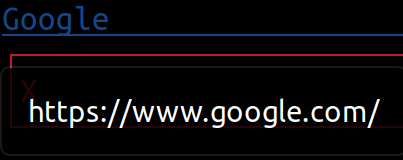DOM
This page describes how to use DOM elements, which can be used for structuring and adding order to the TUI
1. Text
A Text is equivalent to print in most conventional programming languages. It is used for describing the various elements of the UI.
Syntax for defining a Text is:
[color] [Text_style] Text("[string]", "[href]")
Note: The text doesn't resize according to size of terminal video
where
colorwill change the text's color onlystringis the text to be displayedText_stylecan bebold,dim,underlined,inverted,blink,underlined,underlinedDouble&hyperlinkhrefis mentioned only whenhyperlinkTextStyle is used, to provide the link to be opened
Now, lets take a look at some examples, to determine how they work:
-
Yellow and Bold text, saying "This is bold, yellow text"
Yellow bold Text("This is bold, yellow text")which looks like:

-
Red and Inverted text
Red inverted Text("This has an inverted look")which looks like:

-
Blue Text, which links to google.com
Blue hyperlink Text("Google", "https://www.google.com/")which looks like:

Lets see all the text styles together
You can find the full example demo'ed above here: text_styles.qf
2. Paragraph
A Paragraph is used for long-sized text. Hence, it also resizes according to the size of the terminal window.
Syntax for defining a Paragraph is:
[color] Paragraph("[string]")
Lets take a look at an example, to define a MagentaLight Paragraph, with text describing the Bayes theorem:
MagentaLight Paragraph("In probability theory and statistics, Bayes' theorem (alternatively
Bayes' law or Bayes' rule) describes the probability of an event, based on prior knowledge
of conditions that might be related to the event. For example, if cancer is related to age,
then, using Bayes' theorem, a person's age can be used to more accurately assess the
probability that they have cancer, compared to the assessment of the probability of cancer
made without knowledge of the person's age. One of the many applications of Bayes' theorem
is Bayesian inference, a particular approach to statistical inference. When applied, the
probabilities involved in Bayes' theorem may have different probability interpretations.
With the Bayesian probability interpretation the theorem expresses how a subjective degree
of belief should rationally change to account for availability of related evidence.
Bayesian inference is fundamental to Bayesian statistics.")
which looks like this:

Now lets see a video demo for the same:
You can find the full example demo'ed above here: paragraph.qf
3. Separator
A separator is used to segment the TUI about various elements of the UI, like components, blocks, Texts or Paragraphs.
Syntax for defining a separator is:
[separator_type] separator
where the separator_type can be Normal, Light, Heavy, Double or Dashed. If not ,entioned, then the Normal style (which is shown below) is used.
Here is all the types of separators, and their appearance
Vertical{
Text("Normal")
Normal separator
Text("Light")
Light separator
Text("Heavy")
Heavy separator
Horizontal {
Text("Double")
Double separator
Text("lorem ipsum")
}
separator
Text("Dashed")
Dashed separator
Button {
"Exit",
"Exit",
Animated
}
}

You can checkout the example in previous Paragraph's section to see how they are actually used
4. Borders
Borders are used to add a border around any block. It provides a enclosure to the components and DOM elements defined inside the block. It also works for nested blocks (refer to Overview section of the user manual)
To define a border, the syntax is:
[Border_Type] [Block_Alignment] {
...
}
where Border_Type can be Border, LightBorder, HeavyBorder, DashedBorder, RoundedBorder & DoubleBorder, which are described below:
Vertical {
Border Vertical {
Text("This is normal border")
}
LightBorder Vertical {
Text("This is light border")
}
HeavyBorder Vertical {
Text("This is heavy border")
}
DashedBorder Horizontal {
Text("This is dashed border")
}
RoundedBorder Vertical {
Text("This is rounded border")
}
DoubleBorder Vertical {
Text("This is double border")
}
}
